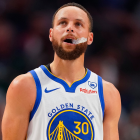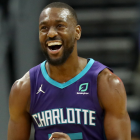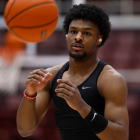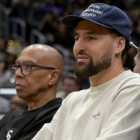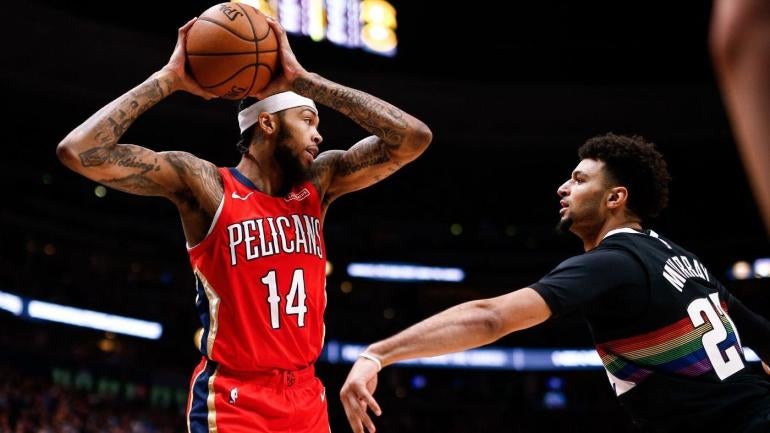
Brandon Ingram is set to be the best restricted free agent on the market this offseason. Unlike most of his top draftmates from 2016, he was unable to reach a contract extension with the New Orleans Pelicans prior to the season. Of course, there were extenuating circumstances involved. Coming off of a scary blood clot, the Pelicans had to be sure that he was healthy before making a big financial commitment. They also couldn't have predicted his breakout campaign. Ingram, a career 32.9 percent shooter from behind the arc prior to this season, is hitting 40.9 percent of his 3-point attempts during the 2019-20 campaign.
That prudence may have made sense in the moment, but as Ingram revealed to Andrew Lopez of ESPN, it was frustrating in the moment. He knew that he was better than many of the players who got paid over the summer, and was ready to prove it on the court.
"When we talked about the extension, of course, I'm human," Ingram said. "When I look at other guys, I'm like, 'This m-----f----- got an extension? Oh my god. Man, we can lace up right now and play one-on-one to 15 and this m-----f----- won't score.' That's how I looked at it as a competitor."
Rarely does a player cite his one-on-one game as a reason he is better than someone else at the NBA level, but Ingram is one of the league's more prolific one-on-one scorers. So let's dig into those comments as they pertain to the rest of the 2016 draft class. Among those who have already earned extensions, who would Ingram beat one-on-one? And where does he stand against them in the context of real NBA basketball?
- Taurean Prince: Two Years, $29 million
If any of these games are really going to conclude with a 15-0 shutout, it would be this one. Prince is a decent role player with high upside as a shooter and defender, but the gap between him and Ingram, either one-on-one or in a real game, is enormous. We're comparing an All-Star to a bench player here. Stop wasting Brandon's time.
- Caris LeVert: Three years, $52.5 million
This would have been much more interesting a year ago when these two were comparable as shooters. Their games, at that point, had some similarities. Both were oversized for their positions and handled the ball extremely well as scorers. The difference is that Ingram learned how to shoot and LeVert hasn't yet. Combine that with his size advantage and the positional scarcity of small forwards, and Ingram is more valuable five-on-five and should win this one-on-one matchup handily.
- DeJounte Murray: Four years, $64 million
Murray's size disadvantage is going to prevent him from getting to the rim, but his improving mid-range game should allow him to at least put up a few points. He is shooting over 47 percent between 10-16 feet of the basket, nearly 42 percent on 2's longer than that. Ingram is better in both areas, though. He is also a better long-range shooter, and that size advantage is enormous in a one-on-one setting. This should be a fairly easy win.
- Domantas Sabonis: Four years, $77 million
Okay, now here is where things get interesting. Sabonis has played like an All-Star this season, but a lot of his value comes from passing. That's out the window in a one-on-one game. His size is problematic for the skinny Ingram, though. Sabonis would be able to back him down with relative ease. Of course, Sabonis isn't exact a stalwart perimeter defender, so he would have no chance defensively against Ingram either. This game might simply come down to who gets the ball first, or who gets unlucky and misses a few good shots first. Ingram is closer to being able to defend Sabonis than vice versa, so he'd have the edge, but Sabonis is the first player here who would have a real chance.
The five-on-five question is far more interesting. The choice is probably Ingram as well. Both positional and skill scarcity tilt in his favor, but if Sabonis is surrounded by shooters and defenders, his all-around offensive game becomes infinitely more valuable. There are teams in which Sabonis could make this interesting, but in a vacuum, it's Ingram.
- Buddy Hield: Four years, $106 million
This would have been a fun stylistic debate before Ingram could shoot. Now he can, and that neutralizes Hield's major advantage. If those two skills are canceled out, suddenly Hield is just shorter and less skilled than the competition. He wouldn't be able to keep up. There may have been a five-on-five argument for Hield at one point based on certain teams needing off-ball shooting wings, but Hield has bristled against his role so frequently this season that it seems like more trouble than it would be worth.
- Jaylen Brown: Four years, $115 million
This is probably the best matchup on the table. Brown and Ingram have similar bodies, but different skill sets. Brown's strength would probably be an issue for Ingram, and his improved shot would prevent Ingram from backing off of him. Ingram's height and length are slightly greater than Brown's, though, so he may simply try to shoot over him. Brown is a better night-to-night defender. Ingram's ceiling is higher. All in all, this would be a close game. Ingram has a slight edge because he's simply a better shotmaker, but Brown could take advantage of the matchup in ways that could easily lead to the win.
- Pascal Siakam: Four years, $130 million
Siakam is the only player on this list that is unequivocally better than Ingram at this moment. One is an All-Star, the other is an MVP candidate. Ingram still has room to grow, but at the moment, there isn't a question about which of them brings more to an NBA team. The one-on-one question is more nuanced, though. Siakam is only in the 35th-percentile league-wide in isolation efficiency, and his ball-handling, while massively improved from his first few years, is hardly elite. He's so much more consistent defensively that he probably still deserves the nod, but this one is closer.
- Jamal Murray: Five years, $170 million
Denver's Murray extension was culture-driven. The Nuggets believe in rewarding their own, but the juxtaposition of his contract against Ingram's impending free agency is interesting. The Nuggets paid Murray on the hope that he could be their longterm fourth quarter shotmaker. They gave him the max as early as possible in the hopes that he could be that player. Ingram doesn't have the max yet, and he already is that kind of player. The Nuggets would trade Murray for Ingram if they could, yet one has been paid and the other hasn't.
Ingram's size makes this a simple one-on-one calculation. He'd defend Murray better than Murray could hope to defend him. The organizational factors involved in their contracts are far more interesting than that battle, though. New Orleans was cautious with Ingram. Denver was aggressive with Murray. With the benefit of hindsight, both sides may have gone the other way. Had New Orleans acted more decisively, they likely would have gotten a discount on Ingram. The Nuggets certainly could have saved money on Murray by forcing him to test the market. If the max contract restriction was removed and these two players both hit the open market, Ingram's eventual contract would be significantly higher than Murray's.
- Ben Simmons: Five years, $170 million
Simmons is certainly stronger than Ingram physically, and unlike Sabonis, he is more than capable of defending him on the perimeter. The only question is where Simmons finds his points. He's not going to get 15 layups. If he can make a few mid-range jumpers, he can win this game, but shooting over Ingram is no easy task.
The five-on-five question is context-dependent. In their current situations, Ingram is more valuable. He plays on a team that is suited for his strengths and Simmons doesn't. But if Simmons could play power forward or even center with shooters around him? This becomes a different question, one we can't answer yet.










